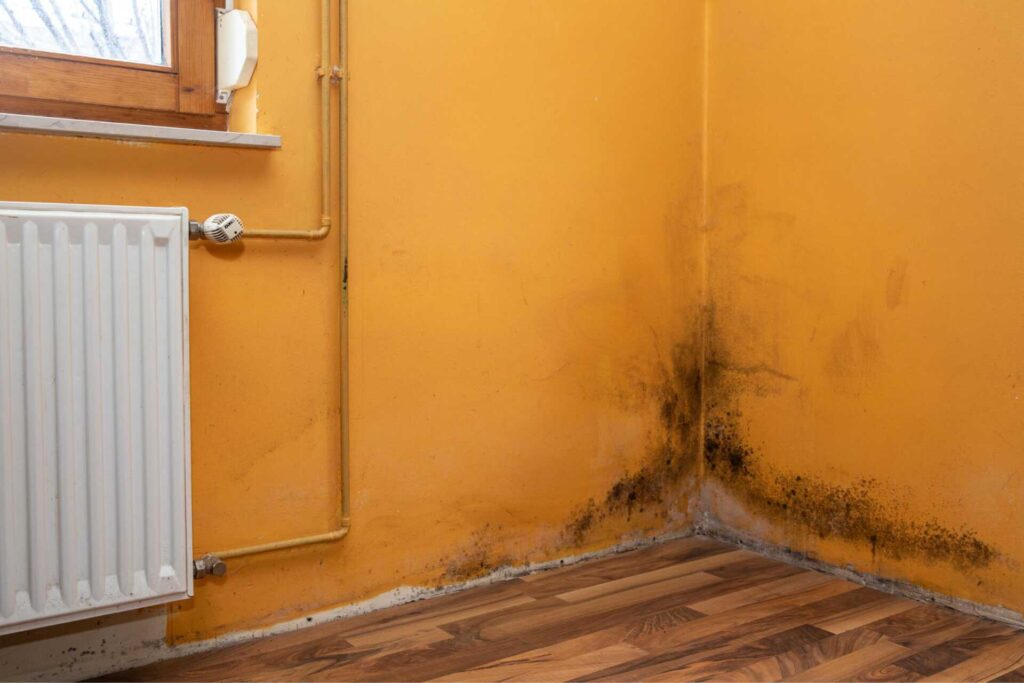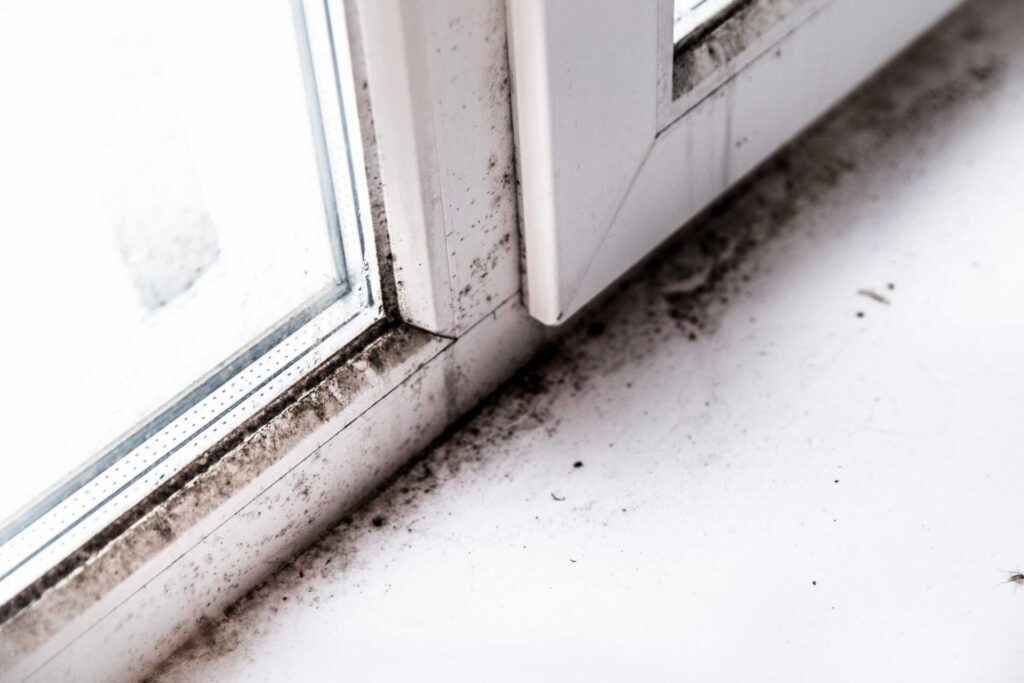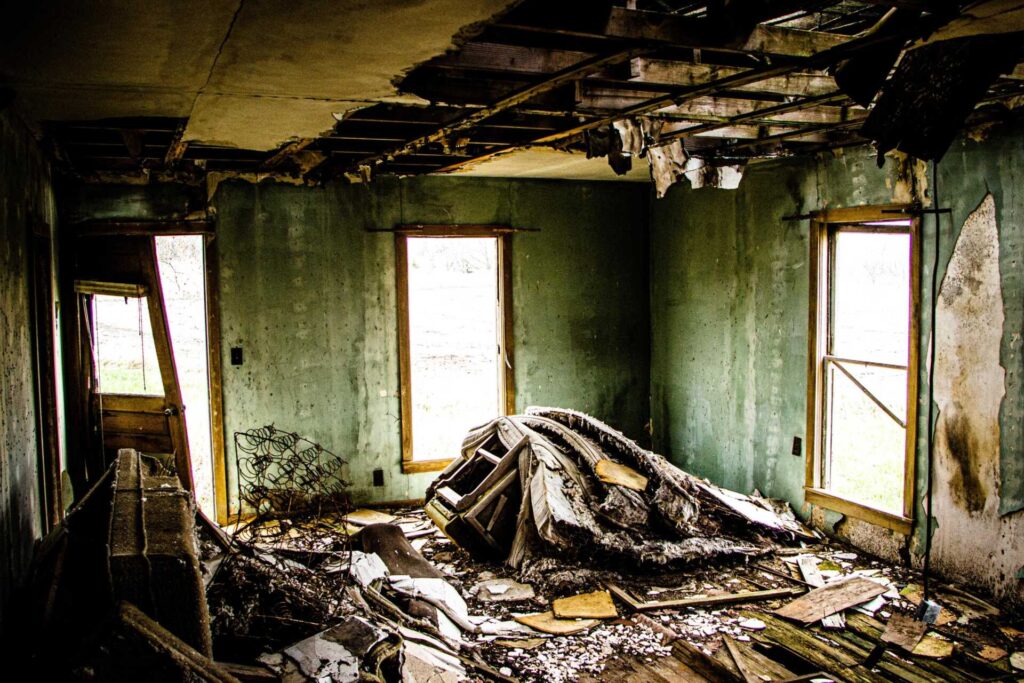
Contents
Black mold can pose serious health risks and damage your home if left unchecked. You need to identify moisture-prone areas and look for visible signs of mold before taking action. It’s vital to prioritize safety with protective gear and proper ventilation. By following effective DIY removal techniques, you can tackle small infestations yourself. But what happens if the mold persists or spreads beyond your control? Let’s explore the steps you can take to guarantee a mold-free environment.
Key Takeaways
- Inspect moisture-prone areas for visible signs of black mold, such as dark spots and musty odors.
- Wear protective gear like an N95 respirator, gloves, and goggles before starting the removal process.
- Use a bleach-water solution (one cup bleach to one gallon water) to spray and scrub affected surfaces thoroughly.
- Rinse the cleaned area and ensure it dries completely to prevent future mold growth.
- Regularly monitor humidity levels and ventilate areas to discourage mold recurrence.
Assessing the Extent of Black Mold Infestation
Before you tackle black mold removal, it’s crucial to assess the extent of the infestation. Start by inspecting areas prone to moisture, like basements, bathrooms, and around windows. Look for dark spots, musty odors, or visible mold growth.
Don’t just rely on sight; check behind walls and under carpets, as mold can lurk in hidden spaces. Use a flashlight to illuminate dark corners, and don’t forget to check HVAC systems and ducts, as they can spread spores throughout your home.
If you find small patches, you might manage them yourself, but larger infestations require professional help. Measure the affected area; if it exceeds 10 square feet, it’s safer to call in experts.
Document your findings with photos, which can guide your removal process and help if you seek assistance. By understanding the extent of the problem, you’ll be better prepared to tackle it effectively and restore your space.
Essential Safety Precautions Before Starting
Before you tackle black mold removal, make certain you wear proper protective gear, including gloves, goggles, and a mask, to shield yourself from harmful spores.
It’s also essential to guarantee proper ventilation in the area by opening windows and using fans, which helps reduce airborne contaminants.
Taking these precautions not only safeguards your health but also enhances the effectiveness of your cleaning efforts.
Wear Protective Gear
Taking safety seriously is essential when tackling black mold removal, and wearing the right protective gear is your first line of defense. Equip yourself properly to shield against harmful spores and chemicals. Here’s a quick guide to the essentials you should wear:
| Gear | Purpose |
|---|---|
| N95 Respirator | Filters out mold spores and prevents inhalation |
| Safety Goggles | Protects your eyes from irritants and debris |
| Gloves | Keeps your hands safe from mold and cleaning chemicals |
| Protective Clothing | Prevents skin contact and contamination |
Ensure Proper Ventilation
Ensuring proper ventilation is essential for your safety while removing black mold, as it helps to minimize your exposure to harmful spores and fumes.
Start by opening windows and doors to create a cross-breeze, allowing fresh air to circulate. If possible, use fans to push stagnant air outside and draw in fresh air.
Make sure to turn off your HVAC system to avoid spreading spores throughout your home. Consider using an air purifier with a HEPA filter to capture airborne particles effectively.
Take breaks outside to clear your lungs and let your body recover from any exposure.
With these precautions in place, you can tackle the mold removal process with increased confidence and safety.
Effective DIY Removal Techniques
While black mold can pose serious health risks, you can tackle it effectively with the right DIY techniques.
First, gather your supplies: rubber gloves, a mask, a spray bottle, and a scrubbing brush. Mix one cup of bleach with a gallon of water in the spray bottle. Spray the affected area generously, letting it sit for at least 15 minutes. This allows the solution to penetrate and kill the mold.
Then, scrub the surface thoroughly with your brush, removing any visible mold. For porous materials like drywall, it’s best to cut out and replace the affected sections.
After scrubbing, wipe the area with a damp cloth to remove residue. Always guarantee good ventilation during this process.
Finally, dispose of all contaminated materials safely, and wash your tools with hot, soapy water. With these techniques, you’ll reclaim your space and create a healthier environment for everyone.
Cleaning and Sanitizing Affected Areas
Before you start cleaning, make certain you’re wearing proper safety gear like gloves and a mask to protect yourself from mold spores.
Use effective cleaning solutions, such as a mixture of water and vinegar or a specialized mold remover, to tackle the affected areas.
After cleaning, don’t forget to properly disinfect the surfaces to guarantee all mold spores are eliminated and prevent future growth.
Safety Precautions First
When tackling black mold removal, prioritizing your safety is essential. Start by wearing protective gear, including gloves, goggles, and a mask to shield yourself from spores.
Verify the area is well-ventilated—open windows and doors to create airflow. If possible, use a fan to help disperse spores.
Before you begin, remove any furnishings or items that could be contaminated, as they’ll need cleaning or disposal. It’s also wise to cover vents and openings with plastic sheeting to prevent spores from spreading to other areas.
Finally, keep a bucket of soapy water nearby for quick clean-up of any spills.
Following these safety precautions not only protects your health but also makes the removal process smoother and more effective.
Effective Cleaning Solutions
To effectively tackle black mold, you’ll need the right cleaning solutions that not only remove the mold but also sanitize the affected areas.
A mixture of one cup of bleach with a gallon of water is a powerful option. Apply it using a spray bottle, and let it sit for about 15 minutes before scrubbing with a stiff brush.
If you prefer a more natural approach, try a solution of vinegar and water in equal parts. Spray it on the mold and let it sit for at least an hour.
Baking soda mixed with water can also be effective for light mold stains.
Always rinse the area thoroughly and dry it completely to prevent future growth. Your efforts will help create a healthier home environment.
Proper Disinfection Techniques
After you’ve removed the visible black mold, it’s crucial to properly disinfect the affected areas to eliminate any remaining spores and prevent future growth.
Start by mixing a solution of one cup of bleach with a gallon of water. Use a sponge or cloth to apply this solution to the surfaces, ensuring you cover every inch. Let it sit for at least 10 minutes before rinsing with clean water.
For non-porous surfaces, a commercial mold remover can also be effective. Don’t forget to ventilate the area well during this process, as bleach fumes can be harmful.
Finally, allow everything to dry completely. Regularly check the area for any signs of mold returning, and you’ll maintain a healthier environment for everyone.
Preventing Future Mold Growth
Although mold can seem like an inevitable problem, there are effective strategies you can implement to prevent future growth in your home. Start by controlling humidity levels; aim for 30-50% relative humidity. Invest in a dehumidifier if necessary. Additionally, guarantee proper ventilation in bathrooms and kitchens to reduce moisture buildup.
Here’s a quick reference table to help you remember these essential steps:
| Action | Frequency | Impact |
|---|---|---|
| Check for leaks | Monthly | Prevents water damage |
| Clean gutters | Biannually | Reduces standing water |
| Use exhaust fans | Daily | Improves air circulation |
When to Seek Professional Help
Even with the best prevention strategies in place, there are times when mold problems can escalate beyond DIY solutions.
If you’re facing any of the following situations, it’s wise to call in professionals:
Extensive Growth: If mold covers more than 10 square feet, it’s likely a larger issue.
Hidden Mold: Mold in walls, ceilings, or HVAC systems often requires specialized equipment.
Health Concerns: If you or your family have respiratory issues, allergies, or weakened immune systems, don’t take risks.
Recurring Mold: If mold keeps returning after your attempts to remove it, it indicates deeper issues.
Structural Damage: If you notice damage to the building materials, it’s important to get expert help to avoid serious repairs.
Addressing mold effectively is essential for your home’s health.
Don’t hesitate to seek professional assistance when needed—your well-being matters!
Review
As you navigate the journey of eliminating black mold, think of yourself as a gardener. Just as you’d uproot weeds to nurture healthy plants, tackle mold head-on to foster a safe environment. With the right tools and precautions, you can reclaim your space, allowing fresh air to flow freely. Remember, vigilance is key; regularly check for signs of moisture, just as a gardener watches for shadows of encroaching weeds. If the problem persists, don’t hesitate to call in the experts.

